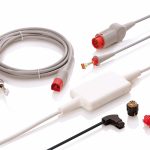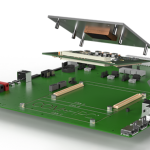“The D-band is the new E-band” stated the shirts worn by Virginia Diodes (VDI) employees at a recent microwave symposium.
Covering 60-90GHz, the E-band is a well-established high-capacity solution for mmWave applications. With radio links to 20Gbps, this band has been an attractive and cost-effective space for design engineers to exploit. However, as we all know, there is need for more, which means moving to higher frequencies such as the D-band, or 110-170GHz.
Infrastructure challenges
At present there is no comprehensive infrastructure to support this move, and there’s a question whether it can be built in the next 5-10 years, when moving to new parts of the spectrum is no longer optional.
In telecoms alone, supporting billions of users at higher data rates requires higher and higher frequency bands. Also, it is not just the telecoms that needs the added bandwidth, but industries like military and defence, remote sensing and security, atmospheric science, radio astronomy, and automotive, too. Yet, lack of available millimetre wave (mmWave) components is creating a two-pronged problem: First, system designers making active electronics above 100GHz will need mmWave components. Second, they will also need cost-effective and high-performance equipment for testing those components, which leads back to the components, since these will be needed for that equipment. These inter-dependent conditions slow developments, with only incremental steps being made at best.
Bridging the gap
The problem extends beyond just the dearth of test and measurement equipment for mmWave and THz frequencies; there’s also the problems of cost and mobility. When moving from the design to the production stage, more of these systems will be needed, so for them to be afforded in larger quantities, they must be smaller and cheaper.
As any system designer knows, it can be quite difficult to move the sensitive and bulky T&M equipment around a production facility. Vector network analysers (VNA) manufacturers have already responded with streamlined USB based devices that are smaller, portable and cheaper than their benchtop counterparts. The only restriction is that they only operate at microwave frequencies (26.5-75GHz).
To make these systems smaller, some companies are now releasing custom modules that pair high-performance extender analysers with the new VNAs. We are VDI manufacture these extenders, which can reach over 1,100GHz. For the new compact USB VNAs, the company has extended the T&M capabilities to the lower end of the THz band (400GHz), bridging the gap between low cost and high performance.
Seeing is believing
At the latest microwave symposium, the extender analyser technology was tested on a patent-pending mmWave hybrid circulator (150-190GHz). Manufactured by Micro Harmonics, the new component can theoretically cover entire waveguide bands, with relatively low insertion loss and over 20dB of isolation. This allows greater volumes of data through systems operating in the upper regions of the mmWave spectrum.
It has already paid dividends for Micro Harmonics, which under a two-phase Small Business Innovation Research (SBIR) contract awarded by NASA, is developing a complete line of hybrid circulators operating in every standard waveguide band from 50-250GHz.
By providing a major boost to existing T&M equipment, VDI is using many of the advancements VNA manufacturers have developed in the lower microwave frequency, which will spur more innovation and development in this space.
Incremental steps
Another huge benefit of utilising new VNAs at higher frequencies is the ability to generate multiport measurements.
“Typically, we have only been able to get either a one-port measurement or a two-port measurement at a time,” said David Porterfield, Founder and CEO of Micro Harmonics. “Now there are VNAs that can test up to eight measurements at once. For companies looking to ramp up production, they can greatly increase the rate of testing.”
This is especially important to companies that fully RF test each component using over 1200 data points across the band.
Micro Harmonics has really innovative in the mmWave and THz fields, having designed a full line of mmWave isolators from 50-400GHz; it is these that enable our extender analysers to operate at the very high frequencies.
Having a low-cost option for VNAs used in conjunction with the mmWave extender analysers will allow developers to move equipment around more easily. Additionally, due to the small USB form factor, they can also be used in the field, since many more customers are now looking for mobile setups. They want to take the equipment on building roofs, to perform so-called “channel sounding” to determine a signal’s propagation.
The next frontier
There are several challenges facing system designers looking at the next frontier of radar and communication systems. The physics restricts building components at frequencies above 100GHz. As we move up the electromagnetic spectrum, the wavelengths get shorter, requiring the constituent parts to decrease in size. As at mmWave frequencies parts are tiny, even the smallest misalignment can significantly degrade performance.
Micro Harmonics’s Porterfield believes those challenges will be overcome, however: “We are talking about transmitting a billion bytes of data in a single second at the D-band. That is like catnip – so, everyone is looking for ways to make it happen sooner, rather than later.
By Diane Kees is the COO at Micro Harmonics, and Greg Rankin, technical writer










